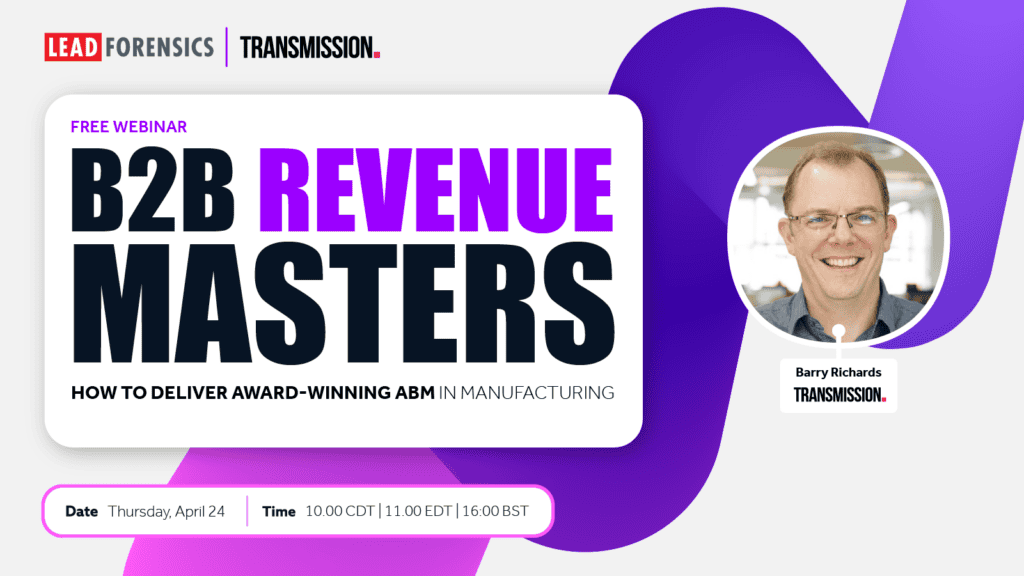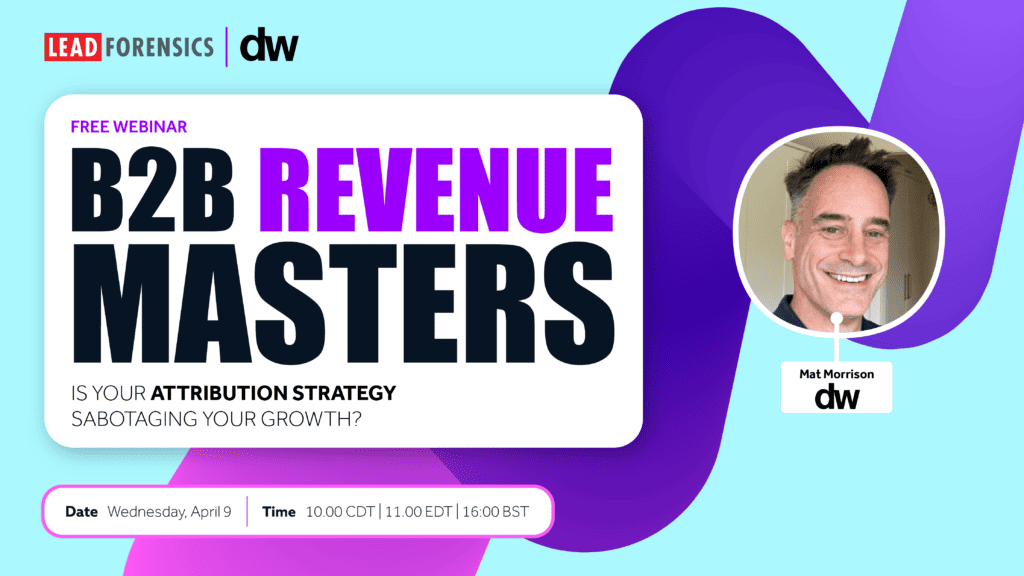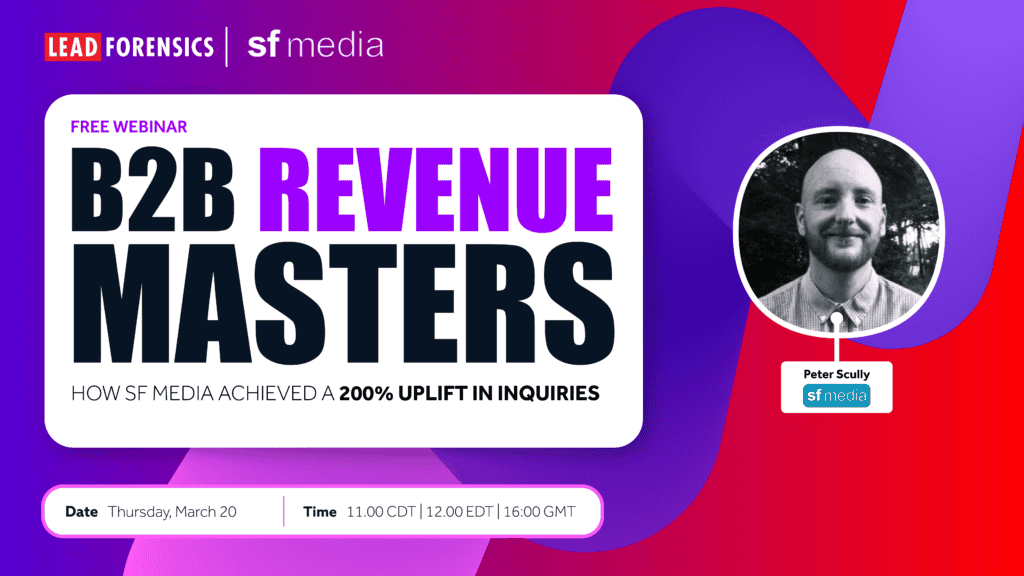Essential Tips for Getting your Sales to Close
This short webinar walks you through the Lead Forensics selling methodology - how our professionals engage in conversations, the buying signals they look for, and ultimately; how to close a deal.
Webinar topic detail
You know how it feels to lose a sale. You know how it feels when a prospect is losing interest. But how do you turn those situations around? In this webinar, you’ll see what today’s sales leaders are doing to close their deals, turn negative situations around, and so much more. Learn how asking questions can bring a customer on a journey of understanding their issues to buying your solution, the buying signals you should look out for, and the 3 golden rules Lead Forensics professionals swear by.
Inah: Hello everyone and welcome to today’s Lead Forensics Sales Masterclass webinar: Essential tips for getting your sales to close. My name is Inah and I will be presenting today’s session.
Today we will be going over
3 Golden rules
Buying signs
Ways to close
Asking the question
Key takeaways
Our guest speaker today is Jeremiah, he will help you get over the final hurdle of closing the sale. He’ll share some top tips about how you can get that sale and of course how to push your prospect over that line.
So over to you Jeremiah.
Jeremiah: Thanks Inah, so let’s start with the 3 Golden Rules.
These 3 golden rules are indicators to look out for throughout the sales process to ensure that the outcome is going to be what you want. So let’s take a look.
They must want what you’re selling or at least think that they do. So whatever it is, product or service that you’re offering, they’ve got to want it in some way. They must believe in what you are offering. So they’ve got to believe what you’re saying is actually going to do exactly what you are telling them. They have to believe. So does that product do exactly what you’ve said? Does that service provide the things that they need? Now sometimes you may not be able to demonstrate that wholeheartedly in a face to face sales meeting or perhaps even over the phone. So instead of that, what they need to believe in is you. People buy from people so if you have a good relationship with your prospect this will certainly help them build their belief in your product or your service. Lastly, they must understand and agree to the proposition. So do they really know what they are agreeing to or are they saying yes to a contract of 17 years or agreeing for someone to come into their office? Make sure they are very clear in what they are committing to.
Once you’ve hit those 3 elements, wherever you are in your sales process we should be looking at a close. So at the point you realise you know what they want, they want what you’re selling, they believe in what you are offering and they understand what they are agreeing to, you should be closing.
Buying Signs
Now leading on from the 3 Golden Rules, we have to ask how do you know that these things are happening? We’re going to look at some buying signs. Buying signs come in all different shapes and sizes. One of the first things we can look out for is if somebody has taken the time to look at your website. That’s a buying sign. They are showing an interest in your product or service. People only visit B2B websites when they have a need and an interest. So if they have visited your site, you have ticked off the first golden rule and you have our first buying sign. Now using a tool such as Lead Forensics will give you this information and at the end of the webinar, we’ll give you an opportunity to sign up for a free trial.
Secondly, if they have taken the time to ring you or you are meeting them face to face and they start asking you questions, once again these are buying signs. Questions like, how quickly can this be delivered? Would it fit, what size does it come in? What price? When can I start my contract? All of these are very critical questions that need asking and essentially what they are saying is “I want your product, I just need to have these questions answered.” Questions are a strong buying sign.
Now there are other buying signs that we may see that are potentially more so. So other than asking questions, we sometimes use verbal indicators. These are verbal signs. If you think about it, when you’ve been talking to people perhaps down at the bar or at the supermarket or at work and they are saying things like “right”, “ah ha”, “ah, okay”, they’re not really saying anything other than keep talking to me. Exactly the same happens in sales. If your prospect is making these noises, it essentially means they’re interested in what you’re saying.
Of course you can do physical signs as well. If you’re demonstrating a product or showing someone a product, they lean out to actually touch it or they are interactive with it or they are nodding to what you are saying. These are physical versions of buying signs. They are all good signs and don’t forget the biggest physical sign is a very big smile on someone’s face. This tells you that the prospect is buying into you and potentially your product or service.
Lastly, you do get the opposite as well. Essentially, non buying signs or negative signals. Negative signals could be where they are saying “well, I’m sorry that’s too expensive”. While these are objections, you can handle these and bring the prospect around to your product or service.
The bulk of today’s session is going to be looking at the different ways you can close the sale and the key here is it’s not always about using the same close in every situation. It’s about mixing it up. So let’s have a look at 10 different ways that you can close.
Ways to Close
First of all, we are going to start with something called the Trial Close or it could be known as the Test Close, as well. Very simply, it’s an open question you are going to use to find out someone’s thoughts or ideas and use it as a gauge to see where you are in the sales process. On screen you can see
“How do you feel about this?” “How does that sound?” ”After hearing all this, what’s your thoughts?”
The idea is that you are using a very open question to gauge where you are in the sales process. The great thing here is, if someone comes back to you by saying “that looks great” or “that sounds ideal”, you are already ticking off the golden rules by using this way to close your sale. Of course, if it doesn’t work out and they say ”that is not really very good”,you’ve lost absolutely nothing by using the trial close. So trial closes are completely safe.
You can also use someone’s objections to help close a sale as well. The key thing here is that you must be confident that you can overcome the objection. Let’s take the example on the screen.
So someone says “does it come in green?” for example and you know it does, you can turn around quickly and
“ If it does, would you like to go ahead?” and that’s really a very good way around being positive around objections and it’s also a very positive way to view that objections can be an opportunity to close the sale.
With our second scenario, “that’s a bit too much money”. If you product or service does enable you to offer your prospects some other options, then you could reply with “well if I could offer you a way to spread the cost, would that be of interest to you?” The great thing is you turn an objection into a close because what we’ll do then is demonstrate how our product or service meets their objection. But you know at that point you’ve actually got the close.
Let’s move on to number 3. The Direct Close. This is the bluntest question you can ask.
“Would you like it?” “Do you want to go ahead with the contract?” “Would you like to purchase?” “Do you want it?”
The key thing here is the reply is going to be a yes or a no and that the beauty of the direct close. It’s very clear as to what the outcome is going to be. The most common fear about closing is the fear of rejection. So when using this type of close you want to make sure they are going to say yes and the key way to do that is to watch out for your buying signs. If you’ve got enough buying signs and you feel they are going to say yes, go for it and use the direct close. Essentially you want to use this way of closing when you are absolutely sure they are going to say yes.
Our fourth close is the Recommendation Close. This close does really provide you with a very consultative approach and it puts you forward as a specialist. This is very useful when you have been having a conversation with someone and you’ve established their needs. Now you know the product or service you have provides a great option for them and this is when you can go straight in with “well I recommend the next steps would be….” and it really allows you to put yourself forward as a specialist. So if you want to make it safe and you can do this with all of the closes really, you can just add “how does that sound?” at the end. By using the trial close, you can make it completely safe. The recommendation close allows you to put yourself forward in a strong consultative position, showing your prospect that you understand what they need.
A much more subtle way of closing is the Minor Point close. This close is all about focusing on your product’s accessories or secondary services. So for example, if I was looking at a sofa by focusing on “when are you looking to take delivery?” The fact they are telling me that they are wanting to take delivery at the end of the month, they are saying yes to that product or service. Another way of looking at this is if you are offering additional services. So if your product or service actually does have add-ons, elements that are above and beyond your main product, if you talk about those additional services, by them saying “yes I would like to take that package”, they’ve got to be agreeing to the main product or service itself. It’s a very subtle way of closing that works really well and can only be done when you are talking about additional services, extras and that type of thing.
So let’s move on to number 6, which is the Summary Close. Now using this type of close you need to make sure you listen. If you don’t listen very well to your prospect, it just won’t work. If you do listen though and you have picked up that there are certain parts of the offer within your service or product and you can list them back to them, this is a great close. For example, I’ve been talking to my prospective customer for a little while and I have repeated back to them “so I’ve been listening to what you’ve been saying, I can understand there are some things that are really important to you. So you are looking for 24/7 support, a short contract and you want to be able to talk to a person and not a machine”. Now as long as you have listened correctly after each of those, they are going to say yes and all you need to do is say “we can do all of those, let’s go ahead”. Then the final yes is going to be there and you’ve got the close.
Let me give you the Alternative Close. It’s very simple and it works extremely well when you have options for your product or service. As you can see on the screen here, it will sound something like
“Would you prefer the black or the white one?” “Which suits you better, the standard package or the premium?” “Do you want the X or the Y?”
Actually at this point, I’m only giving two options. That’s quite important because it means the person you are talking to is now technically calling the shots and that can be very important sometimes too many decision makers. Of course it will be easy to say what if they don’t choose either? It’s not a complete disaster because then you might want to use the objection close or it might mean you’ll need to handle the objection altogether.
So let’s come to the Assumptive Close. Now people always say you should never assume anything, I’m sure you’ve heard the saying. Well we’re going to say, forget that saying. Always go in with one big assumption, that the prospect is going to take your product because it’s about closing. Always assume that your product or service is what the client wants. When it comes to a close though, the assumptive close is very popular because when it’s done confidently it’s very effective. There are different ways that we can do that. One way is, if you have documentation or contracts, anything that needs signing, you don’t actually say to them “do you want to go ahead?” You simply say ”right, let’s get that going, just sign here”. The idea is instead of asking them the question “do you want to go ahead?”, you are ignoring that and assuming that they are saying yes.
An alternative way of doing that would be where you can talk about the delivery. For example, “okay great, where do you want us to deliver that?”.
Now let’s look at our two final closes. At number 9 we have our Third Party Close. The third party close is especially designed to find out whether you are talking to the right person or not and this can be very critical. What we need to do is try to establish if we are talking to the right person and the third party close does this very well. As you can see on the screen, we can say “it’s quite usual that these things have to be signed off first, how does that work within your company?” or “most companies have a process to authorise the finances, how does that work here?”
The key thing here is that we don’t want that person you’re speaking to to not feel as if they aren’t the decision maker. They are quite subtly and cleverly worded to discover if I am talking to the right person and sometimes that’s really clear, sometimes it’s not.
And finally, the last is our Thermometer Close. The idea is that you are going to use a scale between 1 – 10 to find out where you are in terms of closing the sale. We have an example here on screen.
“If I was to gauge your interest on a scale of 1 – 10, where would you be?”
Some of you may be thinking, well what do you do if they say 1, which some people do. Well it doesn’t matter because all we need to do now is say “okay, that’s quite a long way off, what do we need to do to get you closer to that 10?” They might say 8 and it’s the same scenario. “Oh that’s pretty good, although it’s not a 10. So what do I need to do to get you to the 10?”
Now if they say 10, that’s it, you know they are ready to close the sale. The idea of the thermometer scale is that you can really mix it up and it’s not just about gauging interest. It can be about saying something like “how close are you to making a decision?”, for example and you can use it in a lot of different ways. It is very similar really to the Trial Close and the fact you are gauging where you are.
When we are talking about different ways to close, it’s really key to have a variety. I’ve had people argue the point with me before that they’ve used a close that works every single time and that’s great to hear. But then of course the question is why should I change because it’s working for me. Well the question shouldn’t be why should you change, it’s what will you gain if you do change? Because if you go around doing exactly the same thing day after day you can’t really expect the results to change. So unless you feel you are getting absolutely every single opportunity to a close, I would say try using a different closing technique. It’s about variety and tailoring the close to the situation. Ideally you want to gauge from the way that you’re talking to different customers whether you need a more subtle close or do you need a close that works well with your product or service or even do you need a very direct approach. Mixing it up and tailoring it will increase your opportunity to close.
This leads us nicely into our final section. Which is Asking the Question. This may sound incredibly obvious however it is a vital part of the process and of course the question will be lots of different things because it’s all about closing.
If you ask more people, you will close more sales. The more you ask, the more you will get. If you don’t ask, the answer will always be no. If you are confident that your customer has hit all of the 3 golden rules and you’ve got some clear buying signs, then it’s time to ask them to sign the contract.
People are scared of the ’no’. Well to get around that one, don’t ask them a direct question. Don’t use the Direct Close because if you say “do you want it?”, they might say no. Whereas if you ask them “what are your thoughts at the moment?”, it’s very hard for them to say no. So if the no is something you fear, try using the Trial Close and it will work very well.
The key takeaways from today.
Timing is everything with sales and one way to make sure it’s the right time is to use the 3 Golden Rules. They must want what you are selling, they must believe in what you are offering and they must understand and agree to the proposition. Once you are confident that your prospect has ticked all of these boxes, then you can move forward.
Look out for any positive buying signs. Such as questions that show they are working out how your solution aligns with their needs, verbal noises and physical tells. Also, watch out for any negative signals that tell you they are not ready and you need to handle any potential objections.
Make sure you adapt your closing technique to the current situation. Different techniques will work better in different scenarios and you will find you are more comfortable with some approaches than others. Try to not stick to the same familiar technique all of the time as you’ll find it won’t always get you the results that you want.
And the main thing to remember here is that techniques are not a silver bullet, they only work if you’ve moved through the rest of the sales process successfully.
Always ask if they are ready to complete the sale, don’t wait for the prospect to ask you. The key thing to remember here is the more you ask, the more you will get.
So we’ve come to the end of our webinar and we really hope you will takeaway some useful tips on the best ways to close sales.
As I mentioned earlier in the webinar, buying signs are so important for you to jump that final hurdle and close the sale. If someone has visited your website, you know that they are interested in your product or service. This is where we can help you. If you are not already aware, Lead Forensics can identify the businesses that are hitting your website. There is a stat out there that says 98% of visitors that hit your website will never inquire. Lead Forensics can tell you who those companies are. Our tool gives you the contact information of the key decision makers of the company, which means closing will be that much easier because you know you are talking to the right person.
As an attendee of this webinar, we are offering you a free trial of Lead Forensics. We will show you a quick demo on how the tool works and set it up on your website completely free of charge for a 2 week trial.
And that’s it from me.
Inah: So as Jeremiah mentioned if you are interested in taking up this offer please do take the opportunity to let us know at https://www.leadforensics.com/contact
Thanks for joining us today and thank you Jeremiah. We hope to see you on one of our next webinars.
Recent Webinars

Marketing
How to Deliver Award-Winning ABM in Manufacturing
Join Lead Forensics and Barry Richards of Transmission - the multi-award-winning ABM agency behind high-impact campaigns for Henkel, Shure, HP and more - for a no-fluff, insight-packed session on how ...
Read more5
Marketing
Is Your Attribution Strategy Sabotaging Your Growth?
For B2B marketers, proving the impact of marketing efforts is frustratingly complex. Traditional attribution models, designed for consumer brands, rarely translate effectively, leaving you stuck with unreliable data and ...
Read more5
Marketing
How SF Media Achieved a 200% Uplift in Inquiries
Marketing leaders, if your Paid Search and lead generation strategies aren’t delivering the right leads, you’re leaving revenue on the table. Join us for this exclusive webinar where ...
Read more5Key Speakers
Jeremiah Nyarko
Sales Leader
Lead Forensics



